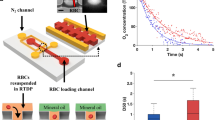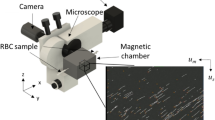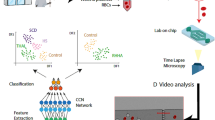Abstract
MEASUREMENT of the relative velocities of corpuscles and plasma by timing the travel of traceable materials between different points in the living body1,2 shows that the mean transit time of the cells is appreciably less than that of the plasma and this is generally attributed to the effect of axial drift of the red cells in the minute vessels. Groom, Morris and Rowlands3 showed that the whole of the cell arrival curve was displaced in time ahead of the plasma arrival curve. Thus some of the red cells apparently advanced bodily ahead of the plasma with which they were injected. Whitmore4 compared these results with those of a theoretical hydrodynamic model, which he developed, and concluded that axial accumulation of cells in streamline flow should only affect the shape of the later portion of the cell-concentration curve; the initial rise of both curves should occur at the same moment and at a comparable rate. Thus such a model did not account for the observed time displacement of the whole cell curve ahead of the plasma curve and the advancement of the leading cells ahead of the plasma with which they were injected.
This is a preview of subscription content, access via your institution
Access options
Subscribe to this journal
Receive 51 print issues and online access
$199.00 per year
only $3.90 per issue
Buy this article
- Purchase on SpringerLink
- Instant access to full article PDF
Prices may be subject to local taxes which are calculated during checkout
Similar content being viewed by others
References
Dow, P., Hahn, P. F., and Hamilton, W. F., Amer. J. Physiol., 147, 493 (1946).
Freis, E. D., Stanton, J. R., and Emerson, C. P., Amer. J. Physiol., 157, 153 (1949).
Groom, A. C., Morris, W. B., and Rowlands, S., J. Physiol., 136, 218 (1957).
Whitmore, R. L., Flow Properties of Blood (edit. by Copley, A. L., and Stainsby, G.) (Pergamon Press, Oxford, 1960).
Bloch, E. H., Anat. Rec., 115, 283 (1953).
Palmer, A. A., Proc. Fourth International Congress of Rheology, 245 (1963).
Palmer, A. A., Amer. J. Physiol., 209, 1115 (1965).
Maude, A. D., and Whitmore, R. L., J. App. Physiol., 12, 105 (1958).
Author information
Authors and Affiliations
Rights and permissions
About this article
Cite this article
PALMER, A. Effect of a Branching Capillary Network on the Differential Flow Velocities of Plasma and Corpuscles. Nature 215, 198 (1967). https://doi.org/10.1038/215198a0
Received:
Issue date:
DOI: https://doi.org/10.1038/215198a0



